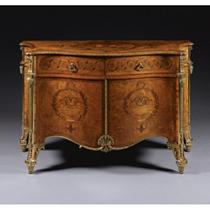 |
| Harrington Commode |
The sold by value calculation was 89%, but that figure is impacted due to the record price for the commode. This single item of furniture represented over 61% of the total for the sale. The commode had a pre sale estimate of near $950,000 to about $1.58 million.
The catalog description for the commode was
THE HARRINGTON COMMODE
the serpentine shaped tulipwood-banded top with a central yellowwood and engraved medallion surrounded by anthemia and a guilloche border with floral sprays and bell-flower inlay, repeated to the front corners, the doors with simulated drawers inlaid with rosettes between interwoven bands and bell-flower divide over shaped panels with oak leaf wreaths enclosing anthemia capped urns with a central beaded mount dividing the doors and an anthemion to the apron, between finely cast gilt-lacquered brass ram's mask, entrelac and husk mounts, repeated to the back corners, the reverse of the doors veneered with black rosewood and now enclosing two conformingly veneered slides, the side panels inlaid with oval paterae within ribbon-tie bell-flower wreaths raised on squared splayed legs with acanthus and bell-flower mounts with Greek-key endings on leaf and gadrooned tapered gilt-lacquered brass feetnthe right frieze handle replaced, the interior adapted from an original configuration of two short drawers over three long graduated drawers to the current two slides that are formed from the original drawers, the underside of the top with mahogany panels inset into the pine carcase, most probably undertaken at the time of manufacture to counteract movement to the top which would be particularly prevalent due to the nature of the fustic veneer. The lack of warping to the top is perhaps testament to the effectiveness of this measure

No comments:
Post a Comment